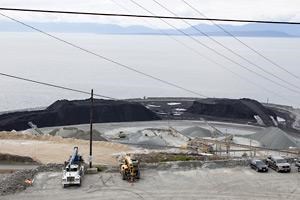Port Metro Vancouver’s decision to approve a transfer facility for US thermal coal ignored the concerns of the Sunshine Coast and other communities that could bear the brunt of the impact, a member of the Salish Sea Coal Committee said last week.
“It was not a good decision for the Sunshine Coast,” committee spokeswoman Lynn Chapman said. “The Sunshine Coast has really been excluded from any consultative process. We are taking all of the environmental and health risk for United States coal.”
Port Metro Vancouver announced August 21 that it had granted a permit to Fraser Surrey Docks after a 26-month review process that it called “unusually extensive.”
The facility is expected to begin operating next year, receiving four million tonnes of coal from the western US by rail. The coal would be shipped on two barges per day to Texada Island, where it would be transferred to cargo vessels for export to Asia.
While Port Metro said it took extra measures to assess potential environmental and human health risks, the environmental review was limited to the federal lands it manages.
“For the Fraser Surrey Docks proposal, this included the terminal site and the portion of the barge route that is in the Fraser River—it does not include the rail corridor from the Canada/US border to the terminal site, nor the barge route in the Strait of Georgia to the receiving terminal at Texada,” Port Metro said in an FAQ (frequently asked questions section) on its website.
Earlier this year, the Salish Sea Coal Committee enlisted the support of Sechelt First Nation, Sunshine Coast Regional District and other environmental groups in an effort to lobby the provincial government to consult communities along the barge route to Texada. Despite concerns also raised by local health authorities, the province did not accede to the request.
In April, the provincial ministry of energy and mines granted a permit to Lafarge Canada Inc. to double the size of its coal-handling facility on Texada to accommodate the extra volume from Fraser Surrey Docks.
Chapman said the committee met with John Weston, MP for West Vancouver-Sunshine Coast-Sea to Sky County, last month and, at Weston’s invitation, attended a meeting between the Future of Howe Sound Society and Colin Carrie, parliamentary secretary to the federal environment minister, a week later.
“We did make a request to Mr. Carrie for a full environmental assessment for that part of the project that is outside the purview of Port Metro Vancouver…but there was zero commitment,” she said.
At the meeting, Chapman pointed out the barge route would run through Sabine Channel, between Texada and Lasqueti islands.
“It has four parks in it, a conservation area, glass sponge reef,” she said. “It’s a crazy, crazy plan to take it that way. It’s a very irresponsible route.”
The coal will be sprayed to keep dust from blowing off, but can’t be covered because that would create the potential for an explosion, she said.
“Coal dust floats, so if that happens at any point, the coal will be coming on our beaches, it will be coming into our ecosystem. Even if there’s not a spill, it’ll be coming in every day.”
In May, the environmental group Voters Taking Action on Climate Change launched a lawsuit against the province, challenging the legality of the ministry of energy and mines’ approval of the Lafarge Canada expansion.
Also at that time, Sechelt First Nation Chief Calvin Craigan threatened to take action, including a possible blockade, if the expansion occurs.
Chapman said the committee was not privy to Sechelt Nation’s plans, adding that public pressure should continue regardless.
“It’s everyone’s responsibility, I would say, even if the silver bullet belongs to Sechelt First Nation,” she said. “We’re hoping common sense will prevail among the politicians responsible and they will do an environmental and health assessment in our area, and that would include consultation in our area and include proper research.”



